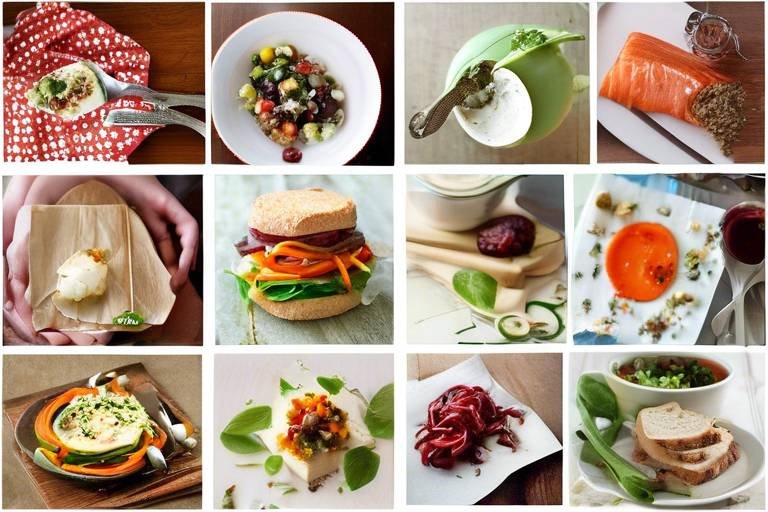Easy Ways to Cook Fish That the Whole Family Will Love
Discovering simple and delicious fish recipes can transform mealtime into a delightful experience for the entire family. Cooking fish doesn't have to be daunting; in fact, it can be one of the easiest and most rewarding culinary adventures! Whether you're a seasoned chef or a kitchen novice, there are numerous ways to prepare fish that will have everyone asking for seconds. Imagine the aroma of grilled salmon wafting through your home or the sight of perfectly baked cod, golden and flaky, ready to be devoured. These methods not only promise flavor but also ensure that your family enjoys a healthy seafood meal.
Let's dive into the world of fish cooking and explore how you can make it a family affair. From grilling to baking, the possibilities are endless. Have you ever thought about how grilling fish can add a smoky flavor that makes it irresistible? Or how baking can lock in moisture, making every bite a juicy delight? By experimenting with different cooking methods, you can cater to various taste preferences, ensuring that even the pickiest eaters find something they love. Plus, involving your family in the cooking process can make it even more fun and engaging. So, roll up your sleeves, and let’s get cooking!
Selecting the right type of fish is crucial for a successful meal. There are so many varieties out there, each with its own unique flavor and texture. For instance, salmon is rich and buttery, while tilapia is mild and versatile. Understanding the flavor profiles of popular fish can help you make informed choices that align with your family’s preferences. Why not try a taste test? Pick a few different types of fish and see which ones your family enjoys the most. You might be surprised at their favorites!
Incorporating fish into your diet offers numerous health benefits. Fish is not only a great source of protein, but it also packs a punch with essential nutrients. From omega-3 fatty acids to vitamins and minerals, the advantages of eating fish are plentiful. These nutrients are vital for maintaining good health, especially for growing children. Are you aware that just a couple of servings of fish a week can significantly enhance your family's overall well-being? Let’s explore these benefits further.
Understanding omega-3 fatty acids is vital for recognizing their health benefits. These essential fats are known for supporting heart health and cognitive function, making them crucial for every family member. They help reduce inflammation and are linked to lower risks of chronic diseases. Think of omega-3s as the superheroes of nutrition, swooping in to save the day for your heart and brain! How about making it a family goal to include more omega-3 rich foods in your meals?
While fish is a fantastic source of omega-3s, there are also plenty of plant-based options and supplements available. For family members who may not enjoy fish, consider incorporating chia seeds, flaxseeds, and walnuts into your meals. These foods can provide the same heart-healthy benefits without the fishy taste. It’s all about finding what works for your family!
Regular fish consumption is linked to improved heart health. Studies have shown that eating fish can lower cholesterol levels and reduce the risk of heart disease. Imagine the peace of mind that comes from knowing you’re serving meals that are not only delicious but also good for your family's heart. So why not make fish a staple in your weekly menu? It’s a small change that can lead to big health benefits!
Fish is packed with essential vitamins and minerals, including vitamin D, B vitamins, iodine, and selenium. Each of these nutrients plays a crucial role in promoting overall health. For instance, vitamin D is essential for bone health, while B vitamins support energy levels. By including fish in your family's diet, you’re not just serving a meal; you’re providing a nutritional powerhouse that benefits everyone!
Cooking fish can be quick and easy. Whether you prefer grilling, baking, or pan-searing, there’s a method that suits different tastes and skill levels. Grilling fish is a fantastic way to infuse it with flavor while keeping it moist. Baking, on the other hand, is straightforward and preserves the fish's natural taste. Each method has its unique charm, making it easy for everyone in the family to participate in the cooking process.
Grilling fish adds a smoky flavor that’s hard to resist. To achieve delicious results every time, consider marinating your fish beforehand. A simple marinade of olive oil, lemon juice, and herbs can elevate the flavor to new heights. Plus, grilling can be a fun outdoor activity for the family. Just imagine gathering around the grill, sharing stories, and enjoying the beautiful weather while you cook!
Baking fish is one of the easiest methods that preserves moisture and flavor. You can simply season your fish with herbs, spices, and a drizzle of olive oil before popping it in the oven. This method is perfect for busy weeknights when you need a quick meal. You can even bake your fish with vegetables, creating a one-pan dish that’s both healthy and hassle-free. It’s a win-win!
Creating fish dishes that appeal to kids can be a challenge, but it’s not impossible! With a little creativity, you can make fish exciting and enjoyable for children of all ages. Think about incorporating fun shapes or colorful toppings to make the meal more appealing. Let’s look at some ideas that can turn your fish night into a family favorite!
Fish tacos are a fun way to introduce seafood to kids. They can be customized with various toppings like shredded cabbage, avocado, and salsa, making them a hit at the dinner table. Plus, kids love to assemble their own tacos, which adds an interactive element to the meal. Who wouldn’t want to build their own delicious creation?
Homemade fish sticks can be a healthier alternative to store-bought versions. By using whole ingredients and baking instead of frying, you can prepare crispy and nutritious fish sticks that your family will love. Pair them with a homemade dipping sauce, and you’ve got a meal that’s both tasty and good for you. It’s a great way to sneak in some nutrition without compromising on flavor!
Q: What types of fish are best for beginners to cook?
A: Fish like salmon, tilapia, and cod are great options for beginners due to their mild flavors and forgiving cooking times.
Q: How can I tell if fish is cooked?
A: Fish is done when it flakes easily with a fork and is opaque throughout. A food thermometer can also help; the internal temperature should reach 145°F (63°C).
Q: Can I use frozen fish?
A: Absolutely! Just ensure to thaw it properly before cooking for the best results.
Q: How can I make fish more appealing to kids?
A: Try fun recipes like fish tacos or homemade fish sticks, and let kids help with the cooking process. Adding colorful toppings can also make it more exciting!

Choosing the Right Fish
When it comes to preparing a delicious seafood meal, is absolutely crucial. Not all fish are created equal, and understanding the different varieties available can help you cater to your family's unique tastes and dietary needs. Some fish are mild and flaky, while others are rich and firm. By knowing what to look for, you can ensure that everyone at the table enjoys their meal. So, let’s dive into the ocean of fish options!
First off, consider the flavor profiles of popular fish varieties. For instance, salmon is known for its rich, buttery taste and is packed with omega-3 fatty acids, making it a favorite among health-conscious families. On the other hand, cod offers a more delicate flavor and flaky texture, making it a great option for those who might be hesitant about stronger fish flavors. If you're looking for something a bit more adventurous, tuna can be a fantastic choice with its meaty texture and bold flavor, ideal for grilling or searing.
It's also important to consider the sustainability of the fish you choose. Overfishing has led to a decline in many fish populations, so opting for sustainably sourced fish can not only be better for the environment but also ensures that you're getting high-quality seafood. Look for labels such as Marine Stewardship Council (MSC) or Aquaculture Stewardship Council (ASC) on packaging, which indicate responsible sourcing practices.
For families with young children or picky eaters, it might be best to start with milder fish varieties. Here are a few options that tend to be crowd-pleasers:
- Tilapia: A mild, white fish that is easy to cook and takes on flavors well.
- Haddock: Another mild option, often used in fish and chips, with a slightly sweet flavor.
- Rainbow Trout: A tender fish that is not only flavorful but also packed with nutrients.
Ultimately, the best fish for your family will depend on personal preferences, cooking methods, and health considerations. Before making a selection, consider asking your family members about their favorite types of fish and any dietary restrictions they may have. This way, you can create a meal that everyone will love and look forward to!

Health Benefits of Eating Fish
Eating fish is not only a delightful culinary experience but also a powerhouse of health benefits that can significantly enhance your family's well-being. With a variety of fish available, incorporating them into your meals can be both tasty and nutritious. Fish is rich in essential nutrients, and its consumption has been linked to numerous health advantages, making it an excellent choice for families seeking a balanced diet. From omega-3 fatty acids to essential vitamins and minerals, fish offers a treasure trove of benefits that support overall health.
One of the standout features of fish is its high content of omega-3 fatty acids. These essential fats are crucial for maintaining heart health and supporting cognitive function. They help reduce inflammation, lower blood pressure, and improve cholesterol levels, which are vital for keeping your family's hearts strong and healthy. Regular consumption of fish can lead to a significant reduction in the risk of heart disease, making it a smart choice for every family member.
Additionally, fish is a fantastic source of high-quality protein, which is essential for growth and development, especially in children. Unlike many other protein sources, fish is generally lower in saturated fat, making it a heart-friendly alternative. Moreover, fish is packed with important vitamins and minerals, such as:
- Vitamin D: Essential for bone health and immune function.
- Vitamin B12: Crucial for nerve health and the formation of red blood cells.
- Selenium: An antioxidant that plays a key role in metabolism and thyroid function.
These nutrients are vital for maintaining energy levels and promoting overall health, especially in growing children and active adults. Incorporating fish into your family's diet can help ensure that everyone gets the necessary nutrients for optimal health.
Another remarkable aspect of fish is its versatility in cooking. Whether you prefer grilling, baking, or pan-searing, there are countless ways to prepare fish that can cater to different tastes and preferences. This adaptability makes it easier to introduce fish into your family's meals without the fear of rejection from picky eaters.
In conclusion, including fish in your family's diet not only introduces a variety of delicious flavors but also provides a wealth of health benefits. From supporting heart health to supplying essential nutrients, fish is a fantastic food choice that can help your family thrive. So why not make fish a regular feature on your dinner table? Your taste buds and your health will thank you!
- What types of fish are the healthiest?
Fatty fish such as salmon, mackerel, sardines, and trout are considered some of the healthiest options due to their high omega-3 content.
- How often should we eat fish?
It is recommended to eat fish at least twice a week to reap the full health benefits associated with its consumption.
- Can children eat fish?
Yes, fish is safe and healthy for children, but it’s essential to choose low-mercury options and ensure they are cooked properly.

Omega-3 Fatty Acids Explained
When it comes to nutrition, omega-3 fatty acids are often heralded as one of the key players in promoting overall health. But what exactly are these magical fats, and why should we care about them? Well, omega-3s are a type of polyunsaturated fat that our bodies can't produce on their own. This means we need to get them from our diet, primarily through fish and certain plant sources. Think of them as the unsung heroes of our meals, quietly working behind the scenes to support our health.
These fatty acids come in three main forms: Ala (alpha-linolenic acid), Epa (eicosapentaenoic acid), and Dha (docosahexaenoic acid). Each type plays a unique role in our health:
- Ala is primarily found in plant oils, such as flaxseed and chia seeds, and is essential for heart health.
- Epa and Dha are predominantly found in fatty fish like salmon, mackerel, and sardines, and are crucial for brain function and reducing inflammation.
Why should you prioritize omega-3s in your family's diet? Well, research suggests that these fatty acids can significantly contribute to heart health by lowering triglycerides, reducing blood pressure, and preventing the formation of plaque in arteries. They also play a vital role in supporting cognitive function, which is especially important for children as their brains develop. Imagine omega-3s as the fuel that keeps your family's mental engines running smoothly!
Moreover, omega-3 fatty acids have been linked to improved mood and mental health. Studies indicate that individuals who consume adequate amounts of omega-3s may experience lower levels of depression and anxiety. It's like having a little sunshine in your diet, brightening your mood and helping you tackle the day with a smile.
Incorporating omega-3s into your meals doesn't have to be a chore. Simple changes, like swapping out a meat dish for a fish dinner a couple of times a week, can make a world of difference. For instance, consider trying a delicious salmon recipe or adding some walnuts to your salads. The key is to make it enjoyable and appealing, especially for kids who might be hesitant about trying fish.
In summary, omega-3 fatty acids are essential for maintaining a healthy lifestyle. By understanding their importance and incorporating them into your family's meals, you're not just serving food; you're serving up health benefits that can last a lifetime. So, why not start today? Your heart and brain will thank you!

Sources of Omega-3s
When we talk about omega-3 fatty acids, most people immediately think of fish, and for good reason! Fish like salmon, mackerel, and sardines are among the richest sources of these essential fats. However, if you or someone in your family isn't a fan of seafood, don't worry! There are plenty of other ways to incorporate omega-3s into your diet. It's all about being creative and exploring various options.
For those who prefer plant-based sources, flaxseeds and chia seeds are fantastic alternatives. These tiny powerhouses are packed with alpha-linolenic acid (ALA), a type of omega-3 that your body can convert into the more potent forms found in fish. Just sprinkle some of these seeds on your morning yogurt or blend them into a smoothie for a nutritious boost. Similarly, walnuts are a delicious snack that provides a good dose of omega-3s. You can toss them into salads, oatmeal, or enjoy them on their own!
Another great option is hemp seeds, which have a delightful nutty flavor and can be added to various dishes. They are rich not only in omega-3s but also in protein, making them a great addition to a balanced diet. If you're looking for a convenient way to get your omega-3s, consider incorporating algal oil supplements. Derived from algae, this plant-based source is perfect for vegetarians and vegans who want to ensure they're getting enough omega-3s without consuming fish.
Let’s not forget about fortified foods! Many products, such as certain brands of eggs, milk, and yogurt, are now fortified with omega-3s. This means you can enjoy your favorite foods while boosting your intake of these essential fatty acids. It’s a win-win situation! So, whether you’re a seafood lover or not, there are plenty of delicious and nutritious ways to ensure your family gets enough omega-3s in their diet.
In summary, the sources of omega-3 fatty acids are diverse and can cater to various dietary preferences. By being mindful of your options and incorporating a mix of these foods into your meals, you can easily meet your family's nutritional needs while keeping mealtime exciting and tasty!
- What are the main types of omega-3 fatty acids? There are three main types: ALA (alpha-linolenic acid), EPA (eicosapentaenoic acid), and DHA (docosahexaenoic acid). ALA is found in plant sources, while EPA and DHA are primarily found in fish.
- How often should I eat fish to get enough omega-3s? It is generally recommended to consume fish at least twice a week to meet your omega-3 needs.
- Can I get enough omega-3s from a vegetarian diet? Yes! By incorporating flaxseeds, chia seeds, walnuts, and algae-based supplements, you can obtain sufficient omega-3s without eating fish.
- What are the health benefits of omega-3 fatty acids? Omega-3s are known to support heart health, improve brain function, and reduce inflammation, among other benefits.

Fish and Heart Health
When it comes to maintaining a healthy heart, fish can be a game-changer in your family's diet. Numerous studies have shown that eating fish regularly is associated with a lower risk of heart disease. This is primarily due to the rich content of omega-3 fatty acids found in many fish varieties. These essential fats help to reduce inflammation in the body, lower blood pressure, and even decrease triglyceride levels. But how does this all translate into tangible health benefits for your family?
First off, let's break down what omega-3 fatty acids do for your heart. They help to keep your heart rhythm steady, which is crucial for preventing arrhythmias—irregular heartbeats that can lead to serious complications. Additionally, omega-3s have been linked to improved cholesterol levels, specifically by raising the good HDL cholesterol while lowering the bad LDL cholesterol. This balance is vital for maintaining heart health and preventing the buildup of plaque in the arteries.
Moreover, consuming fish can also lead to better blood vessel function. The nutrients in fish help to keep blood vessels flexible and reduce the risk of atherosclerosis, a condition where arteries become narrowed and hardened due to plaque buildup. By incorporating fish into your family's meals, you're not just serving a delicious dish; you're also promoting a healthier lifestyle. Just think of it as a tasty way to protect your loved ones' hearts!
For those who might be skeptical about including fish in their diet, consider this: you don’t have to eat it every day to reap the benefits. The American Heart Association recommends at least two servings of fish per week, particularly fatty fish like salmon, mackerel, or sardines. These fish are particularly high in omega-3s and can easily be prepared in various ways to suit your family's taste preferences.
To make it even easier for you, here’s a quick table summarizing some popular fish options and their heart health benefits:
| Fish Type | Omega-3 Content (per 100g) | Heart Health Benefits |
|---|---|---|
| Salmon | 2,260 mg | High in omega-3s, helps lower blood pressure |
| Mackerel | 4,580 mg | Rich in omega-3s, promotes good cholesterol levels |
| Sardines | 2,205 mg | Supports heart rhythm, lowers triglycerides |
| Trout | 1,100 mg | Reduces inflammation, improves blood vessel function |
In conclusion, incorporating fish into your family's diet is not just about enjoying a meal; it's about investing in long-term health. By making simple changes, like swapping out red meat for fish a few times a week, you can significantly improve your family's heart health. So, why not give it a try? Your heart—and your taste buds—will thank you for it!
- How often should we eat fish for heart health? The American Heart Association recommends at least two servings of fish per week.
- What types of fish are best for heart health? Fatty fish like salmon, mackerel, sardines, and trout are excellent choices.
- Can I get omega-3s from sources other than fish? Yes, you can also find omega-3s in flaxseeds, chia seeds, and walnuts.
- Is it safe to eat fish during pregnancy? Yes, but pregnant women should avoid high-mercury fish and consult their healthcare provider for guidance.

Vitamins and Minerals in Fish
Fish is not just a delicious meal option; it's also a powerhouse of essential vitamins and minerals that contribute to our overall health. When you think about it, fish can be likened to a treasure chest, bursting with valuable nutrients that your body craves. For example, fish is rich in vitamin D, which is crucial for bone health and immune function. Did you know that just one serving of salmon can provide more than half of your daily vitamin D requirement? This is especially important for families living in areas with limited sunlight.
Another vital nutrient found in fish is vitamin B12. This vitamin plays a key role in producing red blood cells and maintaining a healthy nervous system. A deficiency in vitamin B12 can lead to fatigue and other health issues, making it essential for everyone, especially growing children. Fish like trout and sardines are excellent sources of this important vitamin.
Moreover, fish is loaded with selenium, a mineral that acts as an antioxidant, protecting your cells from damage. It’s fascinating to think that just a few ounces of fish can provide a significant portion of your daily selenium needs. This mineral is important for thyroid function and helps support a healthy immune system, making it a great addition to your family meals.
In addition to these vitamins and minerals, fish also contains iodine, which is essential for proper thyroid function. The thyroid gland regulates metabolism, and adequate iodine intake is crucial for maintaining energy levels and overall health. Many people overlook iodine in their diets, but fish can help bridge that gap.
To give you a clearer picture of the vitamins and minerals in some popular fish varieties, here's a quick table:
| Fish Type | Vitamin D (IU per 100g) | Vitamin B12 (µg per 100g) | Selenium (µg per 100g) | Iodine (µg per 100g) |
|---|---|---|---|---|
| Salmon | 526 | 3.2 | 36.5 | 24 |
| Sardines | 272 | 8.9 | 52.5 | 35 |
| Trout | 635 | 4.0 | 25.0 | 20 |
| Tuna | 156 | 2.2 | 63.0 | 10 |
As you can see, incorporating fish into your family's diet not only offers a delightful culinary experience but also ensures that everyone benefits from these vital nutrients. It's like hitting two birds with one stone—delicious meals that are also incredibly nutritious!
Q: How often should I include fish in my family's diet?
A: It's generally recommended to include fish in your diet at least twice a week to reap the maximum health benefits.
Q: Are there any fish I should avoid?
A: Yes, some fish may contain high levels of mercury, such as shark and swordfish. It's best to limit these and opt for safer choices like salmon and sardines.
Q: What are some kid-friendly fish options?
A: Fish like cod and tilapia have mild flavors that kids usually enjoy. Plus, recipes like fish tacos or homemade fish sticks can make fish more appealing to children.

Simple Cooking Methods
Cooking fish can be a delightful experience, and the best part is that it doesn't have to be complicated! Whether you're a seasoned chef or just starting in the kitchen, there are several that can transform a plain piece of fish into a mouthwatering meal. Let’s dive into some of the most popular techniques: grilling, baking, and pan-searing. Each method offers unique flavors and textures that can cater to everyone's taste buds, making it easy for the whole family to enjoy.
First up is grilling. This method is not only about cooking but also about creating an atmosphere. Imagine the aroma of fish sizzling on the grill, mingling with the sounds of laughter from your loved ones. Grilling adds a smoky flavor that can elevate the simplest fish fillets. To get the best results, marinate your fish for at least 30 minutes before grilling. A basic marinade of olive oil, lemon juice, garlic, and your favorite herbs can work wonders. When grilling, make sure to preheat your grill and oil the grates to prevent sticking. For those who might be new to grilling, here’s a quick tip: use a fish basket or foil to keep your fillets intact while they cook!
Next, we have baking, which is another incredibly simple method that yields delicious results. Baking fish is all about preserving moisture and flavor, and it’s perfect for busy weeknights. You can wrap your fish in parchment paper or aluminum foil with some veggies and seasonings for a complete meal. This technique, often referred to as en papillote, allows the fish to steam in its own juices, resulting in a tender, flaky texture. Plus, cleanup is a breeze! Just pop everything in the oven, set a timer, and in about 20 minutes, you’ll have a nutritious meal ready to serve. For those who prefer a bit of crunch, try sprinkling breadcrumbs or crushed nuts on top before baking for an added layer of flavor.
Lastly, let’s talk about pan-searing. This method is fantastic for achieving a crispy exterior while keeping the inside moist and flavorful. Start by heating a non-stick skillet over medium-high heat and add a splash of oil. Once the oil is shimmering, carefully place your seasoned fish fillet in the pan. The key here is to resist the urge to flip it too soon; let it develop a golden crust before turning it over. This method works well for thicker cuts of fish, like salmon or tuna. To enhance the flavor even further, consider adding a pat of butter and some fresh herbs to the pan during the last minute of cooking. The melted butter will create a rich sauce that can be spooned over the fish before serving.
In summary, cooking fish can be both simple and rewarding. With these methods—grilling, baking, and pan-searing—you can easily whip up a delicious seafood meal that the entire family will love. Don’t be afraid to experiment with different seasonings and sides to find what works best for your taste preferences. Remember, the goal is to enjoy the process and make mealtime a fun and engaging experience for everyone!
- What type of fish is best for grilling?
Firm fish like salmon, tuna, and swordfish hold up well on the grill. They are less likely to fall apart and can absorb smoky flavors beautifully.
- How long should I bake fish?
Generally, fish should be baked for about 10 minutes per inch of thickness at 400°F (200°C). Always check for doneness; the fish should flake easily with a fork.
- Can I use frozen fish for these cooking methods?
Yes! Just make sure to thaw it completely before cooking. You can also cook fish from frozen, but it may require a few extra minutes of cooking time.

Grilling Fish
Grilling fish is not just a cooking method; it's an experience that can transform a simple meal into a delightful feast. Imagine the tantalizing aroma wafting through your backyard as the fish sizzles on the grill, creating a mouthwatering smoky flavor that makes everyone’s taste buds dance with excitement. But before you fire up that grill, there are a few tricks and tips to ensure your grilled fish turns out perfectly every time.
First and foremost, choosing the right fish is crucial. Some fish, like salmon and tuna, are perfect for grilling due to their firm texture, while others, like tilapia or flounder, may fall apart easily. To make your life easier, consider these popular grilling fish:
| Fish Type | Texture | Flavor |
|---|---|---|
| Salmon | Firm | Rich and buttery |
| Tuna | Steak-like | Meaty and savory |
| Snapper | Flaky | Light and sweet |
| Swordfish | Steak-like | Mild and slightly sweet |
Once you've selected your fish, the next step is to prepare it. Marinating your fish not only enhances its flavor but also helps keep it moist during grilling. A simple marinade can be made with olive oil, lemon juice, garlic, and herbs. Just remember to marinate for at least 30 minutes, but no longer than an hour to avoid the fish becoming mushy.
When it comes to grilling, the temperature is key. Preheat your grill to medium-high heat, around 375°F to 450°F. If you're using a gas grill, this is as simple as turning the knobs. For charcoal grills, ensure the coals are glowing red and covered with ash. To prevent sticking, oil the grill grates before placing the fish on them. You can use a paper towel dipped in oil and tongs to wipe the grates.
Now, let’s talk about timing. Fish cooks quickly, usually around 6-8 minutes per side, depending on thickness. A good rule of thumb is to grill fish for about 10 minutes per inch of thickness. To check for doneness, look for the fish to become opaque and easily flake with a fork. If you're unsure, using an instant-read thermometer can help; the internal temperature should reach 145°F.
As you grill, you might want to consider adding a few vegetables to the grill as well. Bell peppers, zucchini, and asparagus not only complement the fish but also create a colorful and healthy side dish. Just toss them in a bit of olive oil and season with salt and pepper before grilling alongside your fish.
Lastly, presentation is everything! Once your fish is perfectly grilled, serve it with a sprinkle of fresh herbs or a squeeze of lemon juice to enhance the flavors. Your family will be raving about dinner for days!
Q: What type of fish is best for grilling?
A: Firm fish like salmon, tuna, and swordfish are excellent choices for grilling due to their sturdy texture.
Q: How do I prevent my fish from sticking to the grill?
A: Preheat the grill and oil the grates before placing the fish on them to help prevent sticking.
Q: How can I tell when the fish is done cooking?
A: The fish should be opaque and easily flake with a fork. An internal temperature of 145°F indicates it's fully cooked.

Baking Fish
Baking fish is one of the simplest and most rewarding ways to prepare a meal that the whole family can enjoy. The beauty of baking lies in its ability to lock in moisture, allowing the fish to remain tender and flavorful. Imagine pulling a perfectly baked piece of fish out of the oven, the aroma wafting through the kitchen, tempting your taste buds even before you take a bite! It's truly a delightful experience.
When it comes to baking fish, the possibilities are endless. You can choose from a variety of fish such as salmon, tilapia, or cod, each offering unique flavors and textures. One of the best parts about baking fish is that it requires minimal effort while still delivering impressive results. All you need is a baking dish, some seasoning, and a little bit of love! Here’s a simple method to get you started:
- Preheat your oven to 400°F (200°C). This temperature is perfect for cooking fish evenly without drying it out.
- Prepare the fish by placing it in a greased baking dish. You can use olive oil or butter to enhance the flavor.
- Season generously with your favorite herbs and spices. Options like lemon, garlic, dill, or even a sprinkle of paprika can elevate the dish.
- Bake for 15-20 minutes, depending on the thickness of the fish. You’ll know it’s done when it flakes easily with a fork.
For those who enjoy a little extra flair, consider adding vegetables to your baking dish. Slices of zucchini, bell peppers, or asparagus not only complement the fish but also create a colorful and nutritious meal. Just toss them in with a drizzle of olive oil and your chosen seasonings, and let the oven do the magic!
Another fantastic option is to wrap the fish in foil or parchment paper. This method, known as "en papillote," steams the fish in its own juices, resulting in a moist and flavorful dish. Plus, it makes for an easy cleanup! You can even add a splash of white wine or a squeeze of lemon juice for an extra layer of flavor.
Incorporating baked fish into your family’s meal rotation can be a game-changer. Not only is it quick and easy, but it also opens the door to a world of flavors and healthy eating. With just a few ingredients and a little creativity, you can create a dish that pleases even the pickiest of eaters. So why not give it a try tonight? Your family will thank you!
Q: What type of fish is best for baking?
A: Popular choices include salmon, tilapia, and cod, but feel free to experiment with other varieties!
Q: How do I know when my fish is done baking?
A: Fish is cooked when it flakes easily with a fork and has an internal temperature of 145°F (63°C).
Q: Can I bake fish with vegetables?
A: Absolutely! Adding vegetables can enhance flavor and nutrition. Just make sure they have similar cooking times.
Q: What are some good seasonings for baked fish?
A: Lemon, garlic, dill, paprika, and even soy sauce are great options to consider.

Kid-Friendly Fish Recipes
Creating fish dishes that appeal to kids can sometimes feel like a daunting task. But fear not! With a little creativity and some fun recipes, you can turn seafood into a family favorite. Kids are often more willing to try new foods when they’re presented in an exciting way. So, let's dive into some delightful and easy-to-make fish recipes that will have your little ones asking for seconds!
One fantastic way to introduce seafood to children is through fish tacos. These are not just delicious but also customizable! You can start with a mild white fish, like tilapia or cod, which won’t overwhelm their taste buds. Simply season the fish with a bit of lime juice, salt, and pepper, then grill or bake it until flaky. Once cooked, flake the fish into bite-sized pieces and serve it in soft tortillas. Now comes the fun part: toppings! Let your kids choose from a selection of toppings such as:
- Shredded cabbage
- Fresh cilantro
- Sliced avocado
- Cheese
- Yogurt or sour cream
- Fresh salsa
This interactive meal not only makes fish exciting but also encourages kids to experiment with different textures and flavors. You might be surprised at how much they enjoy creating their own unique taco!
Another kid-friendly option is homemade fish sticks. These are a healthier alternative to the frozen versions you find in stores. Start with fresh fish fillets, cut them into stick shapes, and dip them in a mixture of breadcrumbs and your choice of seasonings. You can even add some grated cheese or herbs to the breadcrumb mix for extra flavor. Bake them in the oven until they’re golden brown and crispy. Serve with a side of homemade tartar sauce or a simple dipping sauce like ketchup or ranch dressing. Your kids will love the crunch and flavor, and you can feel good knowing they’re eating something nutritious!
To make things even more fun, consider hosting a “fish night” where the whole family can get involved in the cooking process. Set up a little assembly line for the fish tacos or fish sticks, allowing each family member to contribute. This not only makes for a fun family activity but also teaches kids about cooking and healthy eating. Plus, when they help prepare the meal, they’re more likely to eat it!
In summary, making fish appealing to kids doesn't have to be a challenge. With recipes like fish tacos and homemade fish sticks, you can turn dinner into a fun and delicious experience. Remember, the key is to keep it simple, interactive, and flavorful. Who knows? You might just turn your little ones into seafood lovers!
Q: What types of fish are best for kids?
A: Mild-flavored fish such as tilapia, cod, and haddock are usually well-received by children. They have a subtle taste and can be easily incorporated into various recipes.
Q: How can I make fish more appealing to picky eaters?
A: Try using fun shapes, colorful toppings, and interactive meals like tacos or wraps. Engaging kids in the cooking process can also make them more excited about trying new foods.
Q: Are there any healthy alternatives to fried fish sticks?
A: Yes! Baked fish sticks are a great option. Use whole grain breadcrumbs for added nutrition and bake them instead of frying to keep them healthier.

Fish Tacos
Fish tacos are not just a meal; they're an adventure on a plate! Imagine biting into a warm, soft tortilla filled with flaky, seasoned fish topped with fresh ingredients that burst with flavor. They offer a fantastic way to introduce seafood to kids who might be a bit hesitant about trying fish. The best part? You can customize them to cater to your family’s taste buds!
To make the perfect fish tacos, you can use a variety of fish, but some popular choices include cod, tilapia, or mahi-mahi. These fish have mild flavors that pair beautifully with a wide range of toppings. Start by marinating your fish in a mix of lime juice, garlic, and spices like cumin and paprika for about 30 minutes. This not only enhances the taste but also adds a zesty kick that kids will love.
Once your fish is marinated, you can choose to grill or pan-sear it. Grilling adds a lovely smoky flavor, while pan-searing gives it a crispy exterior that contrasts nicely with the tender fish inside. After cooking, flake the fish into bite-sized pieces and get ready to assemble your tacos!
Now comes the fun part: the toppings! Here are some delicious ideas:
- Cabbage slaw: A crunchy mix of cabbage, carrots, and a splash of lime juice adds freshness.
- Avocado slices: Creamy avocado brings a rich texture that balances the flavors.
- Pico de gallo: Fresh tomatoes, onions, and cilantro create a vibrant topping that brightens each bite.
- Crema: A drizzle of sour cream or a yogurt-based sauce can add a cooling effect.
Assemble your tacos by placing the fish on a warm tortilla, adding your desired toppings, and perhaps a squeeze of lime for that extra zing. Serve them with a side of black beans or rice for a complete meal that will have your family asking for seconds!
Fish tacos are not only delicious but also a fantastic way to get your family excited about eating seafood. Plus, they are easy to prepare, making them a go-to option for busy weeknights. So, why not turn your next family dinner into a taco night? With fish tacos, you can create a fun and interactive dining experience that everyone will love!
Q: Can I use frozen fish for tacos?
A: Absolutely! Just make sure to thaw it properly before marinating and cooking. Frozen fish can be just as tasty as fresh!
Q: What can I substitute for tortillas?
A: If you're looking for a gluten-free option, try using lettuce leaves or corn tortillas. They both work great and add their unique flavor!
Q: How can I make fish tacos spicier?
A: You can add sliced jalapeños, hot sauce, or a spicy salsa to amp up the heat. Just remember to balance it with some cooling toppings like crema or avocado!

Fish Sticks Made Healthy
Homemade fish sticks can be a game changer for families looking to introduce seafood into their children's diets without the guilt associated with store-bought versions. You see, traditional fish sticks can often be loaded with unhealthy fats and preservatives, but by making them at home, you can control the ingredients and ensure they're not only delicious but also nutritious.
So, let's dive into a simple recipe that transforms this classic dish into a healthy option. First off, you’ll want to choose a good quality fish. Some great options are cod, haddock, or even salmon if you’re feeling adventurous. These fish are not only tasty but also packed with omega-3 fatty acids that are excellent for your little ones’ brain development.
Here’s a quick rundown of what you’ll need:
| Ingredient | Amount |
|---|---|
| White fish fillets (cod or haddock) | 1 pound |
| Whole wheat breadcrumbs | 1 cup |
| Eggs | 2, beaten |
| Olive oil | 2 tablespoons |
| Salt and pepper | To taste |
| Optional spices (paprika, garlic powder) | To taste |
Now, the cooking process is as simple as it gets! Start by preheating your oven to 425°F (220°C). While that's heating up, cut your fish fillets into finger-sized pieces. This is a fun step for kids to help with, as they can get involved in the kitchen. Next, set up a breading station: one bowl for the beaten eggs and another for the breadcrumbs mixed with your chosen spices. Dip each piece of fish into the egg, then coat it with the breadcrumb mixture, making sure it's well covered.
Once all your fish sticks are coated, place them on a baking sheet lined with parchment paper. Drizzle a little olive oil over the top to help them crisp up in the oven. Bake for about 15-20 minutes, flipping them halfway through to ensure they cook evenly and turn a beautiful golden brown.
And there you have it! Healthy, homemade fish sticks that are sure to impress even the pickiest of eaters. Serve them with a side of homemade tartar sauce or a squeeze of lemon for an extra zing. Not only are you providing a meal that's packed with essential nutrients, but you're also creating a fun dining experience for your family.
To make it even more exciting, consider letting your kids customize their fish sticks with various dips or toppings. You could have a mini taco night where they can add their favorite toppings, turning dinner into a playful activity!
- Can I use frozen fish for this recipe? Yes! Just make sure to thaw it completely before starting the breading process.
- What can I substitute for breadcrumbs? If you want a gluten-free option, consider using crushed cornflakes or almond flour.
- How can I store leftovers? Store any leftovers in an airtight container in the fridge for up to 3 days. Reheat in the oven for best results!
Frequently Asked Questions
- What types of fish are best for beginners to cook?
For beginners, fish like salmon, tilapia, and cod are fantastic choices. They are not only easy to cook but also forgiving if you’re still mastering your cooking skills. Plus, their flavors are mild enough to please most palates!
- How can I tell if the fish is fresh?
Fresh fish should have a clean, ocean-like smell—if it smells overly fishy, that’s a red flag! Additionally, the flesh should be firm and bounce back when pressed. The eyes should be clear and bright, not cloudy.
- What’s the best way to season fish?
Seasoning fish can be as simple or complex as you like! A drizzle of olive oil, a sprinkle of salt, and a squeeze of lemon can go a long way. For a bit more flair, try adding herbs like dill or parsley, or spices like paprika and garlic powder.
- Can I use frozen fish instead of fresh?
Absolutely! Frozen fish can be just as nutritious as fresh, especially if it’s frozen shortly after being caught. Just make sure to thaw it properly in the refrigerator before cooking for the best results.
- Are there any health concerns with eating fish?
While fish is generally healthy, it's essential to be aware of mercury levels, especially in larger fish like shark or swordfish. Pregnant women and young children should be cautious and stick to lower-mercury options like salmon or sardines.
- What are some kid-friendly fish recipes?
Kids often love fish tacos and homemade fish sticks! Both options can be customized with their favorite toppings or dips, making them fun and interactive meals that are easy to prepare together.
- How can I make fish cooking a family activity?
Involve your family in the cooking process! Kids can help with seasoning, assembling fish tacos, or even choosing the fish at the market. Making it a team effort can turn dinner into a fun bonding experience.



















